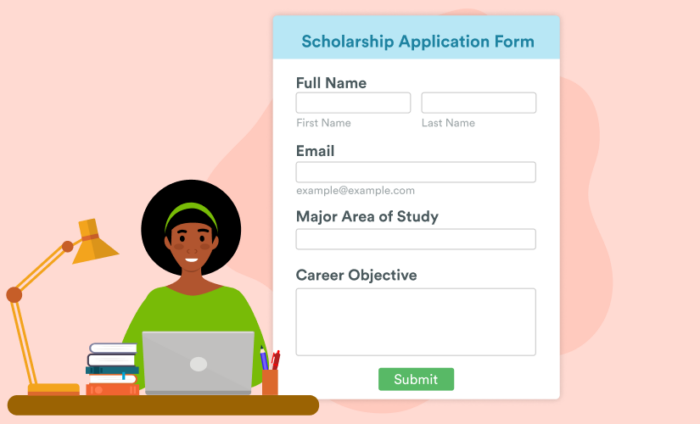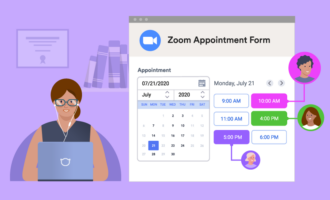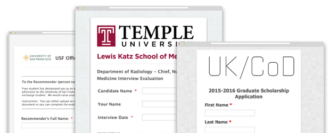Ways to review a scholarship application
Reviewing scholarship applications is a daunting task. When hundreds of applicants submit applications that are multiple pages in length and include numerous attachments, reviewers can quickly find themselves overwhelmed.
That’s why it’s so important to make the selection process as efficient as possible while keeping it fair for everyone who applies. Here are five tips for how to review a scholarship application so the selection committee can more easily move through the review process.
1. Create a simple online application
The application process starts with the application form. The simpler it is to complete and submit, the better for everyone. That’s why using online application forms is so beneficial both to applicants and reviewers.
With online forms, reviewers can leave behind the days when they had to manually collect and sort through paper applications. Using Jotform’s scholarship application template is one way to streamline the application review process.
According to Scholarship America, online application submission forms “reduce material costs, staff time and applicant stress.” This is because they eliminate the need to organize and store hundreds — if not thousands — of sheets of paper.
Online forms allow staff and reviewers to focus their time and energy on the important elements of an application instead of trying to decipher handwriting or attempting to find missing documents. These forms also make it easier to collect supporting documents.
Pro Tip
For an insightful look into the future of higher education, explore “8 Top Trends in Higher Education to Watch in 2024” on Jotform’s blog.
2. Automate submissions of supporting documents
Completing a scholarship application is more involved than simply filling out a questionnaire. Applicants also have to send in supporting documents, such as resumes, essays, cover letters, and letters of recommendation. An online application allows you to automate the collection of these supporting documents — and it gives you the ability to collect videos.
With an online form, you can include a required field for uploading the documents. By keeping the actual application shorter in length, this makes it easier for the reviewing committee to read those documents. Application evaluators can review supporting documents later in the vetting process — when that information is relevant to the selection — rather than having to shuffle through it in the initial review stages.
3. Create a systematic review process
Everyone’s process for selecting scholarship recipients is different. However, most follow the same path, which the University of Florida’s Office of Financial Aid for the College of Medicine has broken down into three stages:
- “Weed out the junk.” In this stage, reviewers do a quick prescreening of applicants to make sure they meet all of the requirements.
- “Pick the contenders.” Judges whittle down the applicants to those most qualified for the scholarship.
- “Pick the winner.” At this point, the committee selects the scholarship recipients.
For scholarship reviews to go smoothly and be fair to all applicants, there must be a set review process for reviewers to follow through each stage. The process needs to explicitly label criteria that are the most important points for consideration. As reviewers move through each stage, they can sort applications based on those criteria.
4. Create a scoring rubric
Once reviewers sort the applications of the top contenders, they have to score the applications to choose recipients. It’s important to create an easy-to-use scoring system that establishes scoring consistency across all reviewers. Creating a scoring rubric helps accomplish this goal.
A rubric is a document that explicitly outlines how reviewers should read and score applications. This scoring rubric used by the Grand Island Public School System in Nebraska for its Career Pathways Institute scholarship illustrates just how specific a rubric is in its scoring criteria. By simplifying and specifying scoring criteria, rubrics like this are helpful for eliminating biases that may interfere with a fair selection process. And when reviewers score everyone consistently, it’s easier to choose a winner.
5. Set guidelines for evaluating applications
When there are multiple reviewers scoring applications, it’s important to provide written guidelines about how you expect everyone to review a scholarship application. This is another key element for ensuring the process remains fair for all applicants. Without specific guidelines in place, reviewers are more likely to create their own processes, which could put some applicants at a disadvantage.
The guidelines from the University of Washington’s Office of Merit Scholarships, Fellowships, and Awards are a good resource for anyone reviewing transcripts, resumes and CVs, essays, and letters of recommendation. The guidelines encourage reviewers to consider specific qualities or information in these documents as they score each element. They help keep reviewers from going rogue or being influenced by biases.
Reviewers must evaluate scholarship applications in an impartial manner so every applicant has an equal chance of being selected for the scholarship. These five tips will help you create a review process that’s fair for everyone and easy for reviewers to follow.








































































































Send Comment: